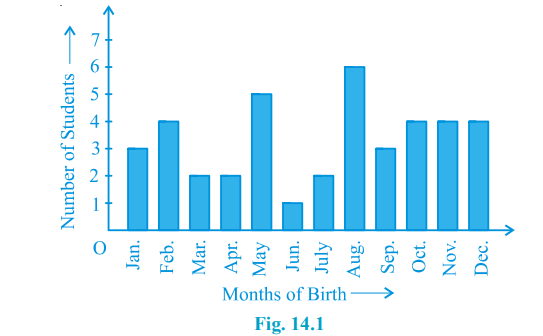The value of upto 50 decimal places is given below: 3.14159265358979323846264338327950288419716939937510 (i) Make a frequency distribution of the digits from 0 to 9 after the decimal point. (ii) What are the most and the least frequently occurring digits?Solution in Punjabi
Step by step video & image solution for The value of pi upto 50 decimal places is given below: 3.14159265358979323846264338327950288419716939937510 (i) Make a frequency distribution of the digits from 0 to 9 after the decimal point. (ii) What are the most and the least frequently occurring digits? by Maths experts to help you in doubts & scoring excellent marks in Class 9 exams.
Topper's Solved these Questions
Similar Questions
In a particular section of Class IX, 40 students were asked about the months of their birth and the following graph was prepared for the data so obtained:
 Observe the bar graph given above and answer the following questions:
(i) How many students were born in the month of November?
(ii) In which month were the maximum number of students born?04:33View Solution
Observe the bar graph given above and answer the following questions:
(i) How many students were born in the month of November?
(ii) In which month were the maximum number of students born?04:33View SolutionShow that each angle of a rectangle is a right angle.
01:25View SolutionMary wants to decorate her Christmas tree. She wants to place the tree on a wooden box covered with coloured paper with picture of Santa Claus on it (see Fig. 13.4). She must know the exact quantity of paper to buy for this purpose. If the box has length, breadth and height as 80 cm, 40 cm and 20 cm respectively how many square sheets of paper of side 40 cm would she require?
03:12View SolutionThe value of πupto 50 decimal places is given below:3.14159265358979323846264338327950288419716939937510. What are the most and the least frequently occuring digits?
02:40View SolutionThe value of π upto 35 decimal placesis given below
3.14159265358973238462643383277950288
Make a frequency distribution of the digits 0 to 9 after the decimal point.02:40View SolutionThe value of π upto 50 decimal places is given below
3.14159265358979323846264338327950288419716939937510
(i) Make a frequency distribution of the digits from 0 to 9 after the decimal point.
(ii) What are the most and the least frequently occuring digits?04:57View Solution50 दशमलव स्थान तक शुद्ध π का मान निचे दिया गया है
3.14159265358979323846264338327950288417716939937510
(i) दशमलव बिंदु के बाद आने 0 से9 तक अंकों का एक बारम्बारता बंटन बनाइए ।
(ii) सबसे अधिक बार और सबसे कम बार आने वाले अंक कौन-कौन से है ?03:10View Solution50 दशमलव स्थान तक शुद्ध π का मान नीचे दिया गया है -
3.14159265358979323846264338327950288419716939937510
दशम बिंदु के बाद आनेवाले 0 से 9 तक के अंकों की एक बारंबारता सारणी बनाकर बताएँ कि सबसे अधिक और सबसे कम बार आनेवाले अंक कौन-कौन-से हैं ?05:12View SolutionThe value of π upto 50 decimal places is given below:
3.14159265358979323846264338327950288419716939937510
(i) Make a frequency distribution of the digits from 0 to 9 after the decimal point.
(ii) What are the least and most frequently occurring digits ?07:18View Solutionpi Below is a list of 50 decimal places. 3.14159265358979323846264338327950288419716939937510 Prepare a version distribution list of digits from 0 to 9 after the decimal point.
04:09View SolutionThe value of π upto 35 decimal places is given below
3.14159265358973238462643383277950288
Make a frequency distribution of the digits 0 to 9 after the decimal point.06:24View SolutionThe value of π up to 50 decimal places is given below :
3.14159265358979323846264338327950288441971693997510
(i) Make a frequency distribution of the digits from 0 to 9 after the decimal point . (ii) Which are the most and the least frequency occurring digits ?05:51View Solutionπ का मान 35 दशमलव स्थानों तक नीचे दिया गया है : 3.14159265358979323846264338327950288 दशमलव बिंदु के बाद आने वाले 0 से 9 अंकों तक की एक बारंबारता बंटन सारणी बनाइए।।
07:58View SolutionThe value of PI upto 50 decimal places is given below :

 : What are the most and the least frequency occurring digits ?01:34View Solution
: What are the most and the least frequency occurring digits ?01:34View SolutionThe value of pi upto to 50 decimal places in given below: 3.14159265358979323846264338327950288419716939937510 From this information prepare an ungrouped frequency distribution table of digits appearing after the decimal point.
06:09View Solution

